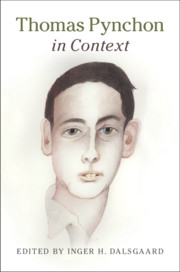Book contents
- Thomas Pynchon in Context
- Thomas Pynchon in Context
- Copyright page
- Contents
- Contributors
- Abbreviations
- Chronology
- Introduction
- Part I Times and Places
- Chapter 1 Biography
- Chapter 2 Letters and Juvenilia
- Chapter 3 Nonfiction
- Chapter 4 East Coast
- Chapter 5 West Coast
- Chapter 6 Europe and Asia
- Chapter 7 Africa and Latin America
- Chapter 8 Geographies and Mapping
- Chapter 9 The Eighteenth Century
- Chapter 10 The Nineteenth Century
- Chapter 11 The Twentieth Century
- Chapter 12 The Twenty-First Century
- Chapter 13 History and Metahistory
- Part II Culture, Politics, and Society
- Part III Approaches and Readings
- Further Reading
- Index
Chapter 4 - East Coast
from Part I - Times and Places
Published online by Cambridge University Press: 31 May 2019
- Thomas Pynchon in Context
- Thomas Pynchon in Context
- Copyright page
- Contents
- Contributors
- Abbreviations
- Chronology
- Introduction
- Part I Times and Places
- Chapter 1 Biography
- Chapter 2 Letters and Juvenilia
- Chapter 3 Nonfiction
- Chapter 4 East Coast
- Chapter 5 West Coast
- Chapter 6 Europe and Asia
- Chapter 7 Africa and Latin America
- Chapter 8 Geographies and Mapping
- Chapter 9 The Eighteenth Century
- Chapter 10 The Nineteenth Century
- Chapter 11 The Twentieth Century
- Chapter 12 The Twenty-First Century
- Chapter 13 History and Metahistory
- Part II Culture, Politics, and Society
- Part III Approaches and Readings
- Further Reading
- Index
Summary
Thomas Pynchon’s early fiction shows relatively little interest in the history of his regional birthplace. His childhood home scarcely influences more than one short story: Introducing Slow Learner (1984) he confesses, “I mistakenly thought of Long Island then as a giant and featureless sandbar, without history, someplace to get away from but not to feel very connected to” (SL 20). As in Slow Learner’s collected stories, virtually nothing in V. (1963) distinguishes rural areas such as western Massachusetts from upstate New York; likewise, little other than the multiethnic demographics of “Nueva York” separate it from Norfolk, Virginia. As his oeuvre developed, however, the East Coast became a font from which flows of power, control, and capital issued; after The Crying of Lot 49 (1966), he scrutinizes East Coast hegemony as threatening freedom and privacy. Despite a tone of frustration and disapproval, however, Pynchon repeatedly identifies historical near-misses where East-Coast culture might have become better in particular ways. He seems unwilling fully to give up hope for a better East and, thereby, a better nation and better world.
- Type
- Chapter
- Information
- Thomas Pynchon in Context , pp. 31 - 38Publisher: Cambridge University PressPrint publication year: 2019

